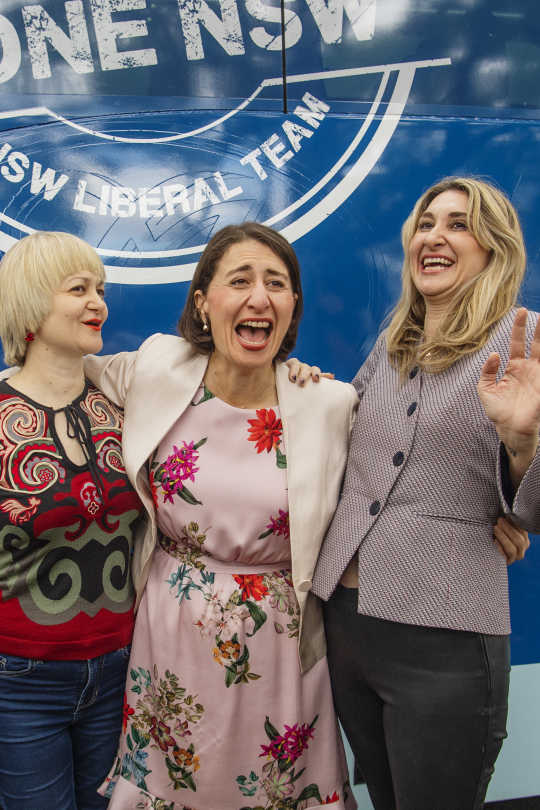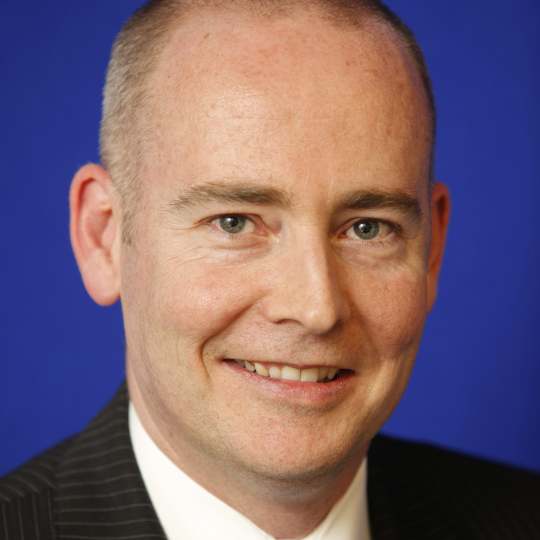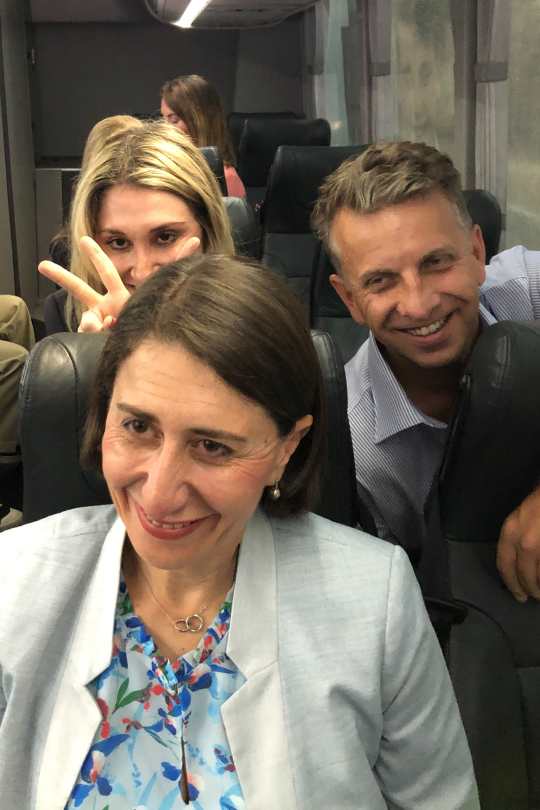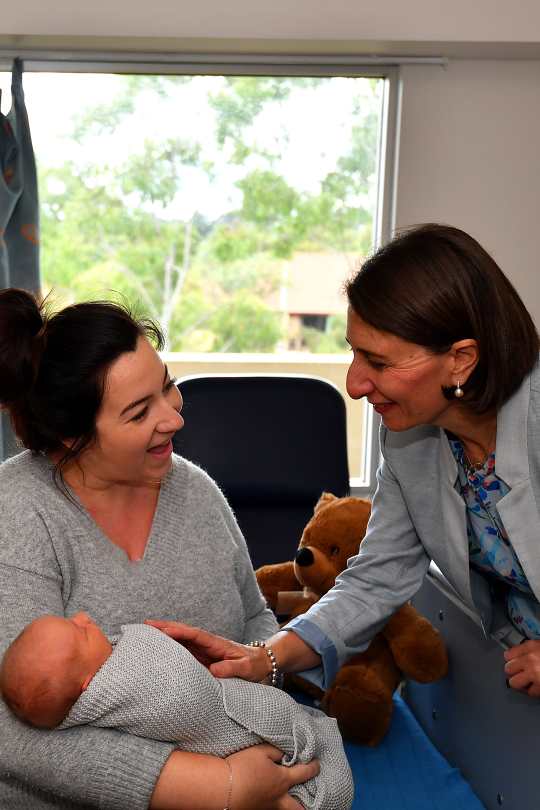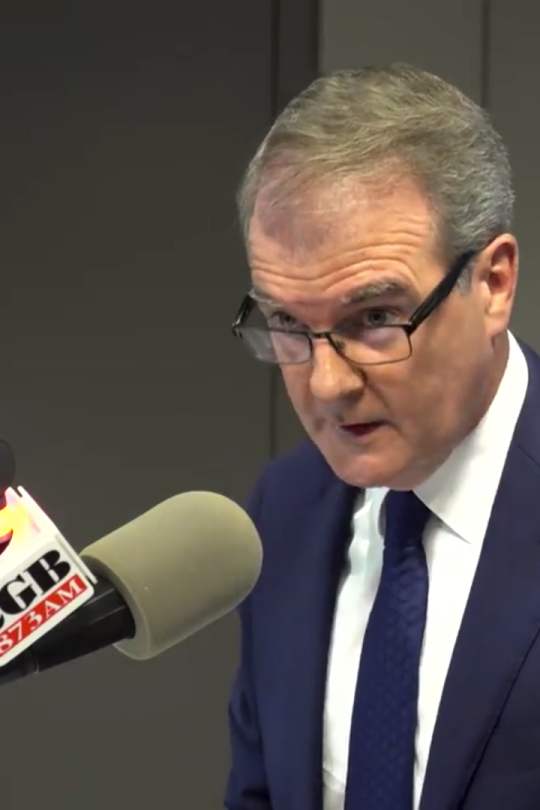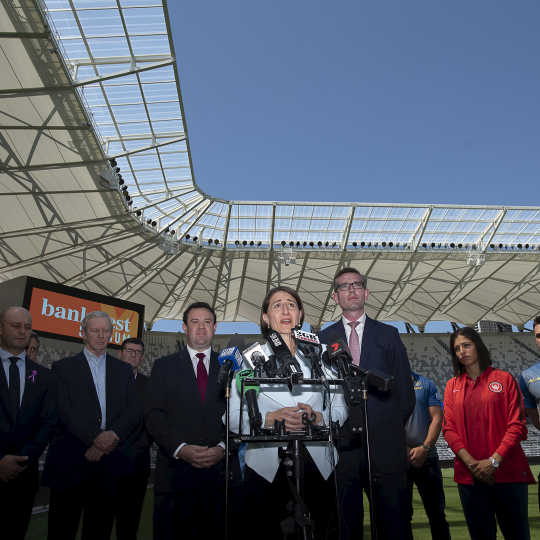Fresh Berejiklian cabinet to be sworn in
NSW's education minister will be a conservative woman for the first time in more than two decades
All government need strong opposition, however, not even one letter to the SMH Supporting what the Premier has done or will do? Strange times ahead indeed ... Honeymoon is over already?
‘Lock them up’? Trump’s attention turns to his enemies list NBC News
Via UK 🇬🇧 ‘Lock them up’? Trump’s attention turns to his enemies list NBC News
‘The Houses of Parliament’ is an anagram of ‘loonies far up the Thames’.
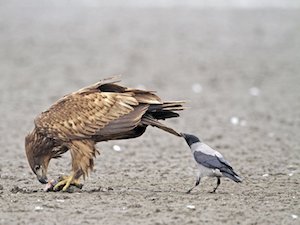
Berejiklian has presided over a secretive government that has done more harm than good, especially to the environment, with big business, developers and party donors the policy beneficiaries. - Marie Healy, Hurlstone Park
The government has trashed the environment for eight years yet the voters returned it to office. Smacks of an electorate out of touch. - David Goldstein, Balgowlah
Silly of me to think possibly a new Environment Minister might actually care about the future of our wildlife (‘‘Premier vows ‘compassion, empathy’’’, April 1). Instead, Gladys Berejiklian says the new Energy and Environment Minister’s priorities will be to keep the lights on and prices down. So the habitat destruction for woodchips and land clearing will continue, our national parks will remain under-resourced, marine parks will be weakened further, feral horses will stay protected, koalas and other species will edge closer to extinction. The majority of people have sadly voted for “business as usual” in NSW. - Karen Joynes, Bermagui
Silly of me to think possibly a new Environment Minister might actually care about the future of our wildlife (‘‘Premier vows ‘compassion, empathy’’’, April 1). Instead, Gladys Berejiklian says the new Energy and Environment Minister’s priorities will be to keep the lights on and prices down. So the habitat destruction for woodchips and land clearing will continue, our national parks will remain under-resourced, marine parks will be weakened further, feral horses will stay protected, koalas and other species will edge closer to extinction. The majority of people have sadly voted for “business as usual” in NSW. - Karen Joynes, Bermagui
If the Premier really wishes to focus on compassion and empathy, she might look at WestConnex. She could consider the people who have been dispossessed of their homes without adequate compensation; the people who have had their homes damaged and the damages dismissed by the damager; the people who will face constant vibrations from motorways 12 metres beneath their homes; and the people who will be poisoned by unfiltered exhaust stacks. Possibly the government could also end stage 3b, which no one apparently wants to build. These actions would bring great relief in the affected areas and show her compassion was real and constructive. - Jon Marshall, Lilyfield
I’m looking forward to the new NSW Parliament passing the law for compassionate, assisted dying for those who are suffering intolerably. Just like Victoria did last year. Until then, it’ll be all talk and no action. - Sue Casiglia, North Ryde
The ministry again leaves the regions wanting. Berejiklian says ministers will be paying more attention to regions that previously had parliamentary secretaries looking after them. We had Scot MacDonald, who did quite a good job as secretary for the Hunter. We now have no one looking after our interests with this Sydney-centric government. - Glenn Jones, Weston
Exclusive
All Hail Gladys: How the Liberal Party won NSW
Facing possible defeat in NSW, Liberal Party leader Gladys Berejiklian decided to out-Labor the Labor Party.
Aaron PatrickSenior Correspondent
Gladys Berejiklian had a problem. Her government was building roads, train lines, hospitals and schools across NSW. Unemployment was down. Economic growth was strong. But a crucial group of voters was oblivious or didn't care about the state election: 35- to 54-year-old women with children.
Unless the buttoned-up Premier could convince what Liberal officials had dubbed "working mothers" that their lives would be improved under the Coalition, Berejiklian would lose its parliamentary majority on March 23, and possibly government altogether. The Labor Party could take over a government with a clean balance sheet and and some $90 billion in infrastructure projects that it could claim credit for as they were finished over the following four years.
With Berejiklian's support, Liberal campaign director Chris Stone decided on a radical strategy: the Liberal Party would out-Labor the Labor Party.
Stone believed that the working mothers, many of them unpaid, in 20 marginal seats would have a big influence on how their adult children and husbands voted. They were the key to power.
There was a problem. Many were too busy to focus on the parties' competing policies. The party's polling firm, C|T Group, convened focus groups of working mums in the second half of 2018 and asked them: "What have you heard on the news about the Berejiklian government?"
The answer: "Nothing."
Soon after Stone hired a Sydney marketing agency that specialised in communicating with young and middle-aged mothers over the internet, Drum Digital. To win them over, they would conduct one of the most ambitious public information campaigns ever run in NSW.
An election haircut
The Premier was sitting in a comfortable chair at her favourite salon flicking through her phone. Aged 48, she had set the display to large to make the messages easier to read.
The former Commonwealth Bank of Australia government relations manager raised her eyes from the screen and gulped. Berejiklian's usual hairdresser was away. The stand in had cut Berejiklian's hair into a flattering but shorter-than-usual bob.
One thought raced through Berejiklian's mind: "People are going to think I chose a different hairstyle for the election."
Impeccably polite to the public, Berejiklian didn't say a word. But she knew that in politics, appearances counted a lot. Female MPs, especially on the right, know they are judged by different criteria to men. Older Liberals often advise hopefuls not to wear necklaces or brooches in public because they are regarded as an affectation. Pearls are political death.
Reversing the ambivalence
Gladys Berejiklian with her sisters Rita and Mary on the last day of the election campaign. Louise Kennerley
Berejiklian was NSW's sixth premier in nine years. She wasn't disliked by voters. She wasn't loved either. Her technocratic image fuelled the ambivalence.
In a society where politicians' families are often an important component of their public persona, Berejiklian was single and childless. She was very private too. Not that she had much time for an outside life. Politics was everything.
Senior party figures, including former premier Nick Greiner, advised Berejiklian that she needed to reveal more of her personality and personal life to charm voters.
Berejiklian understood the political imperative but was uncomfortable exposing her inner self too much, according to people who know her. She would rather be judged on her performance, they said.
The question of whether or how Berejiklian's family should enter the election wasn't decided by the Premier or campaign team. It was made by The Sunday Telegraph. On March 3 the tabloid splashed with an article about younger sister Mary lashing out at menwho had mocked Berejiklian's appearance on social media.
Instead of thanking her sister, Berejiklian disparaged her. "I'm sure every family has a Mary," she said. "You can tell her to tone it down, but that's just Mary."
A friend's daughter
When the Liberal campaign committee started meeting in late 2018, it was worried. The committee was deliberately small, and met in person. Stone and Berejiklian were joined by party president Philip Ruddock, deputy leader Dominic Perrottet, who would become the official campaign spokesman, and Don Harwin, the government's senior upper house MP. They could frankly raise problems without hurting the morale of campaign staff or candidates.
Stone had a good plan, some thought, but did he have enough time to implement it? The party had just lost two byelections, Wagga Wagga and Wentworth, and was stretched preparing for what would be a challenging a federal election.
Stone, the campaign director, had attended North Ryde High School with the Berejiklian sisters. He was in Mary's year. He had an easy rapport with the Premier.
Liberal campaign director Chris Stone went to school with Berejiklian. Supplied
On weekends, Stone and his staff at the campaign headquarters on William St in East Sydney would often bring their children to work to grab a precious few hours together. Televisions around the office would be switched from the ABC and Sky News to Disney Junior.
Berejiklian had fallen for her campaign director's six-year-old daughter, Lily. The premier's eyes would light up when she encountered the child. One day, Berejiklian walked into Stone's office and saw Lily had written a note to her absent father on a whiteboard: "I love you soooooo much Daddy."
Berejiklian, who doesn't seem to have ever discussed her own feelings about motherhood publicly, penned a response inside a love heart. "I love you Lily so much. Premier Gladys XXX," she wrote.
Family decision
One of Stone's objectives was to help Berejiklian become comfortable injecting her family into the election. Berejiklian's natural sense of privacy, perhaps amplified by the tight Armenian community she grew up in, didn't make her eager to deploy her personal life for political purposes. The awkward incident with Mary had made the topic even more sensitive.
To soften Berejiklian's image, a 55-second mock-bloopers video was produced for the official Liberal campaign launch on March 10. In the video, three male ministers demonstrated deference to Berejiklian, who was asked: "Favourite reality TV show?"
"Too many to note," she replied.
Sitting proudly in the audience as Liberal party members lapped up the in-jokes were Berejiklian's parents, Krikor and Arsha, and sisters Mary and Rita.
Morning meetings
The campaign office started operating on January 28. The first telephone hook up was held at 5.30am each day. C|T staff would brief campaign officials on the previous night's polling, which tracked voters' response to the campaign. When Stone printed out a copy the information filled 100 pages.
Once the team understood what was going on in the 16 most important seats, tactics would be discussed at 5.45am. With Berejiklian, Deputy Premier John Barilaro and Perrottet on the line, an agreement would reached on the day's main objectives.
The participants knew they had to be realistic about their powers. A big political event, such as a court ruling on the demolition of the Allianz Stadium, would likely overwhelm everything else.
At 6am the campaign call would switch to the designated messages of the day. If the topics were straightforward, the discussion took about five minutes. On days involving more political conflict, it might take 20 to 30 minutes to agree.
Discipline was important. If candidates deviated from the agreed language, voters would become confused and journalists might play up the division.
Flexibility was needed for parts of the state too. A policy to cut coal's or gas' contribution to NSW's energy production by 2030 had to be pitched differently in the seat of Upper Hunter, where there are coal mines, to Sydney's Coogee, where coal is unpopular.
Afterwards, Stone and his staff would ring around the state – 114 seats were being contested – to let the candidates know what to say.
On the bus
Berejiklian was the public face of the campaign. She made selective appearances on a Liberal-blue bus covered with her slogan, "Let's get it done NSW", that was used to ferry about a dozen journalists, photographers and cameramen to her campaign stops.
Berejiklian would sit among the reporters, chatting and scrolling through her messages. Her staff would hand out Snakes lollies and bottles of water. (Labor leader Michael Daley sat separately to journalists on his bus, which had Tim Tams.)
On the campaign bus Berejiklian was relaxed and jocular. Lisa Visentin
Sometimes ministers would hitch a ride. Belying her stiff public image, Berejiklian deployed an almost-jocular tone. Sports Minister Stuart Ayres was "Stuey" and Education Minister Rob Stokes was "Stokesy".
At C|T, regression analysis was being used to peer into voters' minds. Using multivariate calculus, regression identifies the correlation between between two factors. The analysis was used to track, on a daily basis, whether the Coalition's messages were influencing uncommitted voters in swing seats. The feedback mechanism was used to alter Coalition messages that weren't working, and respond to Labor ones that were.
The data showed there was a problem, and it was located in Canberra. Not long after the federal Parliament resumed sitting for the year on February 12, support for the NSW Coalition started to wane. Every time the news focused on the federal government's internal problems – ministers retiring, Barnaby Joyce posturing, Liberals arguing – Berejiklian was hurt.
The federal government got entangled in the campaign directly too. One of the Coalition's top policies was the promise of before- and after-school care being offered at every public primary school. The policy was so important to winning over working mothers that it was saved for Berejiklian's campaign launch in the at-risk seat of Penrith on March 10.
Berejiklian planned to spend the following day promoting the policy. The Prime Minister had a different priority. He asked for Berejiklian to be present for a federal promise to spend $3.5 billion on a rail line and related infrastructure to a yet-to-be-constructed airport in Western Sydney. Scott Morrison needed to win over female voters too, and wanted the state's female Premier by his side.
State and federal officials have different accounts of what happened. According to one senior NSW Liberal, Morrison's office refused to alter his schedule and threatened to do the announcement without her. Given the airport will be important to the state's economy, a no-show might have looked like Berejiklian had snubbed Morrison for electoral reasons. She went.
"Look, there have been plenty of distractions over the last couple of weeks," Berejiklian said, standing next to Morrison. "I don't deny that, but they haven't distracted me."
Two million letters
Berejiklian knew she had other ways to communicate with voters. Joanna Sharma, the founder of Drum Digital, was sending Liberal Party messages to working mums in marginal seats on Facebook and Instagram.
The ads were almost apolitical. Instead of attacking the Labor Party or repeating political slogans, they laid out the government's plan in friendly, unemotional language. The party avoided the angry world of Twitter, where many voters had already made up their minds.
"Too much screen time can hold back a child's development," one Facebook post said, accompanied by a photo of young girl staring at a computer tablet. "That's why the NSW Liberals are doubling the Active Kids program to $200 a year."
Knowing that many voters are repelled by partisan bickering, the ad didn't mention that the Labor Party planned to reduce the subsidy to $100.
The Liberal Party sent some 2 million individual letters to voters. One was a reproduced hand-written note from Berejiklian introducing a leaflet containing Coalition promises and achievements.
"I know we all lead busy lives, so I though I would send you some information to read in your own time, outlining how my Liberal Team is working to take the pressure off you and your family," the Premier wrote in a neat, light-blue script. "Regards, Gladys."
"The content was unlike anything the Liberals had done before," Stone says.
Budget tricks
In some cases, the Coalition's election promises were less generous than they appeared. In health, much of the funding promised during the campaign had already been committed, which meant it would go ahead if there was a change in government unless the Labor Party reversed specific decisions.
During the campaign Berejiklian and Health Minister Brad Hazzard promised $5.8 billion in upgrades to eight hospitals: John Hunter, Bankstown-Lidcombe, Ballina, the Children's at Westmead and the Children's at Randwick, Royal Prince Alfred, St George and Ryde. Commitments to another 21 hospitals took the total to $8.4 billion.
Berejiklian meets mother Lauren Mitchell and her son, Jordan, at Blacktown & Mount Druitt Hospital, which was promised $700 million. In reality, the Coalition's hospital election promises were one tenth the new funding on offer. AAP
The Parliamentary Budget Office estimated the total costof the Coaliiton's hospital-upgrade election policy at only $884 million over four years – one tenth the amount touted.
On Sunday February 17 – the big policies were saved for quiet weekends – Berejiklian promised to hire 5000 nurses and midwives. Pre-empting a Labor promise a week later to hire more than 5500, Berejiklian said the government was "investing $2.8 billion to recruit thousands of extra nurses, midwives and frontline staff".
When it examined the Coalition policy, the Parliamentary Budget Office discovered that some 4000 of the positions had already been included in the health budget to cover population increases. In reality, the Coalition was offering to add fewer than 1000 extra nurses and midwives to the state's hospitals.
One the Labor Party's most-expensive policies had been neutralised through a budget trick. Voters didn't know or care. As the nightly polling data rolled in, Stone realised something remarkable was happening: they were deciding to trust the Coalition to do a better job on health and education policy than Labor. The conventional rule of politics had been flipped.
The positive campaign was working. Could the negative one too?
Coalition staff had researched Daley's history as a councillor in the beach suburb of Randwick in the 1990s and the 2000s. They found some correlations between property developments he had voted for and donations to the Labor Party.
The information was given to the Daily Telegraph, which used it to question Daley's integrity and link him to corrupt figures from the last Labor government. Sydney's other main newspaper, The Sydney Morning Herald,wasn't convinced by the story and didn't pursue it. Mostly limited to the conservative media, it didn't seem to have much of an impact.
On the defensive
Former Michael Daley turned his campaign around in Alan Jones' 2GB studio. Fairfax Media
Then Daley electrified the campaign on March 5. In an interview with AM radio broadcaster Alan Jones, Daley promised to fire the conservative commentator from the Sydney Cricket and Sports Grounds trust, one of the most prestigious boards in the state. Jones feigned indifference.
The Coalition campaign found itself on the defensive. Opposing the $730 million demolition and reconstruction of Allianz Stadium – an inner-city rugby league and soccer stadium – was Daley's signature policy. Polls showed voters were split, and the media relished the conflict.
Daley demanded Berejiklian halt Lendlease's demolition contract. Premier largely in title only – caretaker mode gave her little actual power – Berejiklian refused to answer clearly 10 times at a press conference when asked if the stadium would be pulled down.
As the evening news was dominated once again by the stadium story, Berejiklian looked defensive and evasive. Several ministers called and suggested she change tactics, according to one Liberal source. They were frustrated and concerned she had miscalculated. "It was very tense," the source says.
Berejiklian's stubbornness was usually a political asset. She didn't get spooked once she had made up her mind. She wasn't easily moved by criticism.
This time, Berejiklian decided to change message. She wasn't going to hide from the story; she was going to embrace it. C|T research had found that the replacement of the 45,000-seat stadium wasn't a top-order concern for swinging voters despite the huge media coverage. They just needed to be persuaded the policy was sound.
The next morning, around 10am, Berejiklian's staff invited journalists to the Western Sydney Stadium in Parramatta. Built but not opened, it is one of three new or refurbished stadiums designed to put Sydney in a position to win global sporting contests such as the rugby World Cup.
Berejiklian, Treasurer Dominic Perrottet and Minister for Sport Stuart Ayres at Western Sydney Stadium the day after the Premier's "no answer" press conference. Nine
In a display of institutional support, Berejiklian was flanked by senior representatives of the National Rugby League, the Sydney and Western Sydney Wanderers football clubs, the state Waratahs rugby union team, and the Parramatta Eels and Sydney Roosters rugby league clubs.
“We’re willing to fight Labor on stadiums,” she said.
Defining Daley
Michael Daley was elected Labor leader in November after his predecessor was accused of a one-off case of sexual harassment. Not long after, an employee of a state MP decided to Google Daley on a train ride home, according to a party source. The Young Liberal found a two-minute news video on YouTube shot by a freelance journalist. It showed Daley speaking to voters in a pub in Wentworth Falls, in the Blue Mountains district.
In the video, Daley described how his adult daughter had moved to Melbourne because immigrants from Asia "with PhDs" had made housing too expensive in Sydney. "Our kids are moving out and foreigners are moving in and taking their jobs," Daley had said, not long before he became leader.
Word of the video spread around the Coalition. Some ministers were told the comments weren't particularly controversial. The government was no proponent of immigration, after all. Berejiklian had asked for the intake to be halved not long before Daley was made leader.
The video in which Michael Daley claimed that young people were leaving Sydney and being replaced by Asians with PhDs. Supplied
The campaign decided to alert its newspaper of choice, the Telegraph, to the existence of the video on Monday, March 18, five days before the election. At 5.13pm the News Corp-owned paper published an article by Anna Caldwell and the video.
Editor Ben English says the timing was aimed at capturing evening readers who might have otherwise first heard about the story on the evening television news.
The Herald quickly placed a story on its homepage too. In the following days – as many voters were starting to first focus on the election – 730 separate news reports were written and broadcast about the comments. Nothing else Daley said during the campaign generated as much media coverage, according to an internal analysis by theTelegraph.
The comments helped crystallise voters' concerns that Daley was too untested to be premier. Berejiklian's Armenian background meant she epitomised the contribution that immigration had made to society.
Six seats would cost the Coalition its majority. As Daley's comments reverberated around the media universe, C|T found the swing to Labor was happening in only three seats of the most important seats, East Hills, Coogee and Penrith.
The working mums had chosen Berejiklian.
"None of the other seats were shifting," a party source says.
On election day, the Liberal Party lost one seat, Coogee. The Nationals lost one seat to the Labor Party, and two to the Shooters, Farmers and Fishers Party.
After claiming victory at the official Liberal Party function at the Sofitel Wentworth Hotel around 9pm, Berejiklian was driven to her electorate campaign party in the Lower North Suburb of Willoughy. She says she got to sleep about 1am.
Some of her staff ended up at Star Casino, one of the few venues in Sydney that can sell alcohol late under the Coalition's tough licensing laws.
A visit to the governor
Last Tuesday Berejiklian arrived at Government House in the front seat of a white Subaru, tailed by police bodyguards in a Range Rover. Three independent MPs had promised to support the government a day earlier, giving her a four-seat majority after appointing a speaker.
After informing Governor David Hurley she had the confidence of the Legislative Assembly, Berejiklian strode to a group of journalists waiting under a large tree on the immaculately mowed lawn.
Before election day Berejiklian had mostly given full, albeit deflective, answers to even the most pointless questions, which all journalists ask sometimes. Now, she didn't bother.
"Now you are turning your mind to a reshuffle," she was asked. "Obviously reshuffles are always a bit of a minefield. People aren't necessarily always happy with the way that it goes. When you do only have a small buffer are you worried about, essentially, the backbench going nuclear, threats to move to the backbench and causing a byelection?"
"No, I'm not concerned about any of those things," Berejiklian replied, smiling a little.
On Sunday she announced a cabinet that includes the first "minister for customer service" and promised more work to help troubled juveniles, lower the suicide rate and keep people out of jail.
Historians may come to consider Berejiklian the most successful female Liberal ever, eclipsing former foreign minister Julie Bishop and pioneers such as Amanda Vanstone, Jocelyn Newman and Enid Lyons.
Although only in the job two years, Berejiklian led her party into a hostile political environment, defied conventional campaign strategy to win over a disengaged electorate, and lost only two seats to the opposition in a state that had been a Labor centre of power since unionist James McGowen became premier in 1910.
"We see her as the Iron Woman of the Liberal Party," says one of her newly promoted ministers.
If the Coalition loses power federally this year, Berejiklian will become the most powerful Liberal in the country. Her ministers are already talking about favourable conditions for victory in four years' time. The government's big infrastructure projects will have been completed, Berejiklian will have had time to implement her social agenda, and voters tend to favour opposing political parties in power in the state and federally. Sixteen years of Coalition rule is within grasp.
All hail Gladys.

|
NSW
MOG: Out with the old, in with the new, and where everyone is
going.
|
||
|
CAREERS: Post-election
movements in NSW and pre-election appointments at the Commonwealth. Welcome
to a bumper edition of movers & shakers.
|
||
|
|



